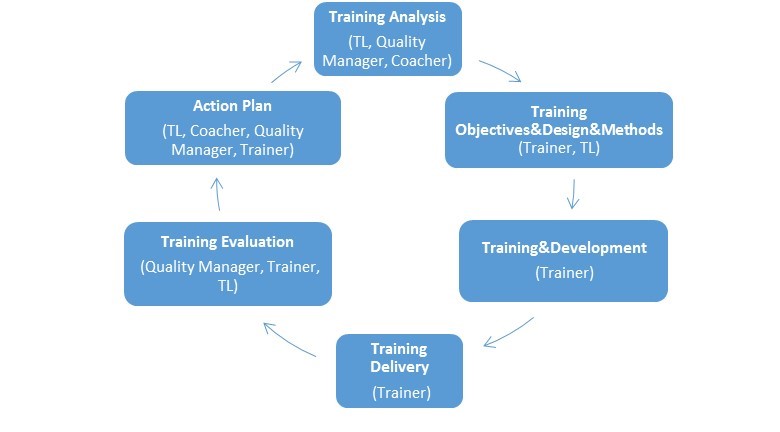Training Flow Strategy in Service Centers

Nowadays, the outsourcing business is in continuous progress. If you ask the opinion of a project manager, low-cost service at the best quality standards is one of the major issues discussed in the field. The executives have proven that apart from the low-cost profile, the business value is also an important aspect of a call centers business.
An essential aspect when it comes to service centers is the customer orientation, according to the client’s needs. A client service delivery will survive only if there is a continuous performance in customer service orientation. There are two elements contributing to a qualitative service center: a meaningful recruitment process and a high performance learning strategy. The key to a customer service that gives the best results is to know the connection between a company’s branding strategy, the service center’s goals and the results of the training program, and to understand their implications.
After a qualitative recruitment process according to the company’s standards, a training strategy should also be implemented so as to build solid results. There are two main reasons for implementing training strategies in a service center: new hires, and refreshment trainings.
Below, you can find illustrated the strategy of a refreshment training, using a standard service center hierarchy structure:

This strategy is split in three parts: a pre-course, a core-course and an after-course phase. One of the processes included in the pre-course phase is the Training Need Analysis. Identifying the needs of a refreshment training should be the team leader’s and the quality manager’s task, who, after studying the low quality issues, are able to identify the training needs. This may be done either through customer satisfaction reports and testimonials or other relevant reports according to the company’s standards. In the pre-course phase, the team leader also establishes the objectives along with the trainer, and the latter has to design the structure of the training or refreshment training based on these. This is the part where the two members need to agree on the key learning points according to the needs of the company or client.
The next stage of the pre-course phase is the research for documentation purposes, which entails looking for pertinent proven information, collecting data and designing the training, implementing the necessary learning strategies. The audience should be well determined, because the training strategies should be adapted to the audience’s level of understanding. In general, the in-house trainer, or the trainer working on a specific project, is already familiar with the employees of the company.
The core-course phase is, in fact, equivalent to the delivery of the training before the entire team or before some of its members. The training should be well adapted to the company’s needs and delivered accordingly.
The after-course phase includes the Training Evaluation and the Action Plan for the next training needs. The evaluation of a training’s effectiveness in a service center can be performed objectively by collecting data from customer satisfaction results, analyzing statistics, coming up with a trend in terms of customer satisfaction. According to this kind of reports and analyzed trends, the team leader, the project manager, the coacher and the trainer can conclude whether the training was effective and pass to the next step: establishing the Action Plan. The action plan can refer to the same training, if it did not have the desired outcomes, or to the next training’s objectives. This after-course phase is a teamwork responsibility.
On the other hand, the training for a new hired agent should follow a different strategy: the training plan is a universal agent approach. This kind of training is designed so that it develops the universal agent, in the specific culture, for the implemented career path. The company can ensure quality agents if they implement trainings for management positions. The aim of this kind of training for the new hires can represent a good stimulation for the agent, establishing a motivation factor.
After new hire trainings, which aim at creating the universal agent in a specific company culture, the role of the managers is to identify talent, design trainings for talents and coach them, so that the company can explore their potential. The benefits are bivalent, for both the company and the agent, whose talent will, thus, be well trained, coached and put to good use, offering a feeling of appreciation.
In conclusion, the training strategy implemented in a service center business has a major impact on customer satisfaction. Agents get in contact and communicate with clients on a regular basis. Therefore, having a good training strategy is vital for a company as the training provided can make agents feel part of that company’s image in the eyes of the client. Choosing the right people in the hiring process is important, but guiding and preparing them in the right way is a process that adds a consistent value to the service center business.
References:
- Sims, G., Smith, M., Pack, K., Rude, R., Salisbury D., Kull, A. (2009), 44 Call Centre Training Tips
- Nardin, T. (2006), Hiring and Training for the Call Center
- Metric Net (2014), Call Center Best Practices
Image source:

Tags: Service center, Training strategy





